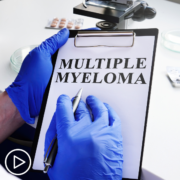How Targeted Therapy Works to Treat Myeloma
How Targeted Therapy Works to Treat Myeloma from Patient Empowerment Network on Vimeo.
Nurse practitioner Charise Gleason explains how targeted therapies work to fight myeloma and how they may be used in combination. Charise also discusses how targeted therapies differ from radiation chemotherapy.
Charise Gleason is a nurse practitioner specializing in myeloma and serves as the Advanced Practice Provider Chief at Winship Cancer Institute of Emory University. Learn more about Charise, here.
Related Programs:

|

|

Myeloma Targeted Therapy: Why Identifying Chromosomal Abnormalities is Key |
Transcript:
Charise:
Plasma cells or myeloma cells have a target on the outside. And so, CD38 is a very common one. You think of daratumumab, for instance, that targets CD38, because it’s on the surface of every plasma cell.
You have what’s called CS1 on the surface of plasma cells that elotuzumab targets.
And these drugs target that particular marker to break down that myeloma cell in a different way. The reason we use combination therapies are not just because we think this is a great idea to put them together. We know dexamethasone, for instance, is going to make that plasma cell more presentable and make that target more presentable to let, for instance, daratumumab work on it. And then you take something like an immunomodulatory agent that works in another way. But as far as targets, that’s on the surface of the cell is what we’re looking for on that particular one.
With the translocation, that’s one that’s very specific. If you take a translocation (11;14), those patients can express high BCMA, another target on a plasma cell.
And so, that’s the reason again why that works for some of those patients, because it attaches and kills the myeloma starting from that outside and working into the cell.
The traditional chemotherapy approaches just worked at killing everything, including normal cells, right? And so, you have a patient who gets admitted for chemotherapy, for instance, it knocks everything down and with that, the myeloma. And then those cells come back up. And so, you think of that more from a traditional admit to the hospital. We give several days of chemotherapy or the conditioning regimen for transplant with melphalan It wipes out everything.
And so, sometimes we still need to do that and do that maneuver to reset the bar. But there’s more risk to the patient with that, we’re making a patient more immunocompromised. With targeted therapy, it’s more specific to that target. So, it’s really working more to kill those abnormal cells in there. So, the patient doesn’t experience quite that same immunosuppressive state where everything is knocked down.










